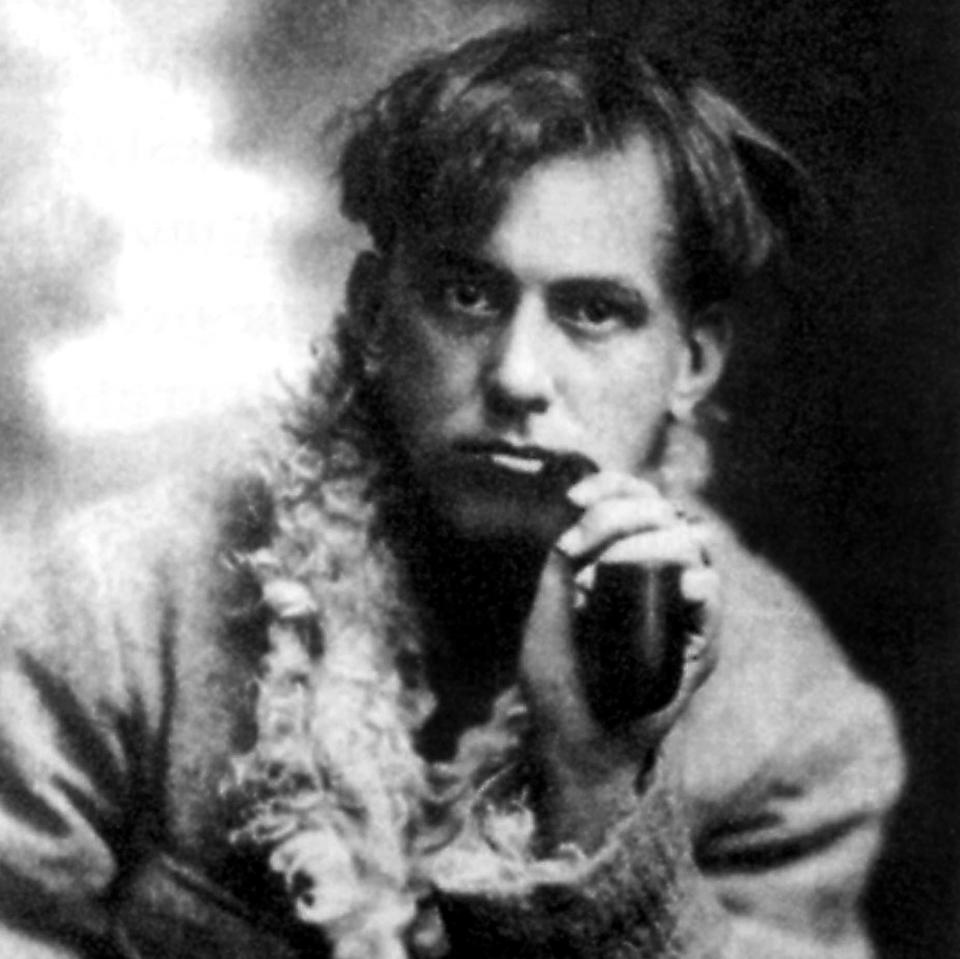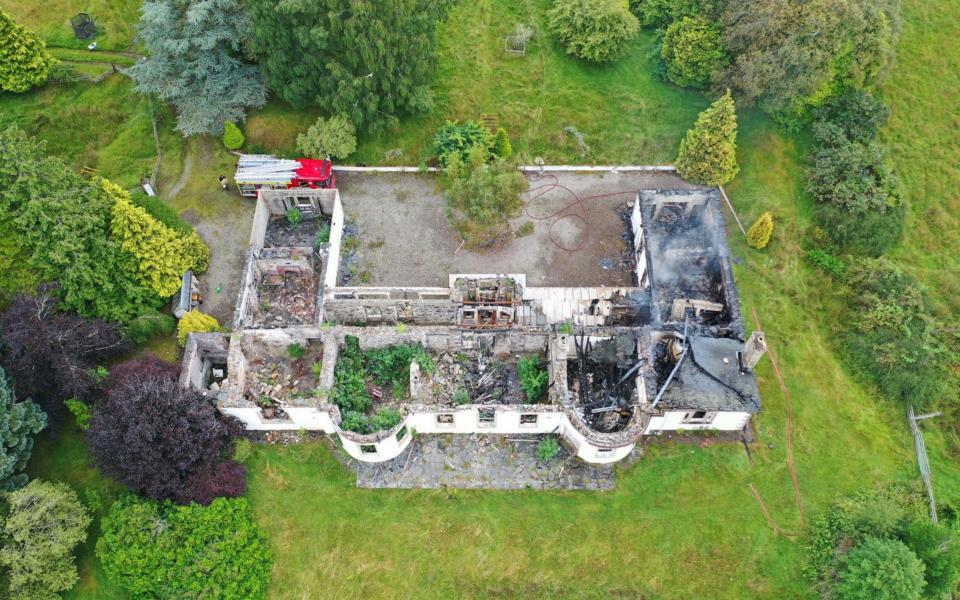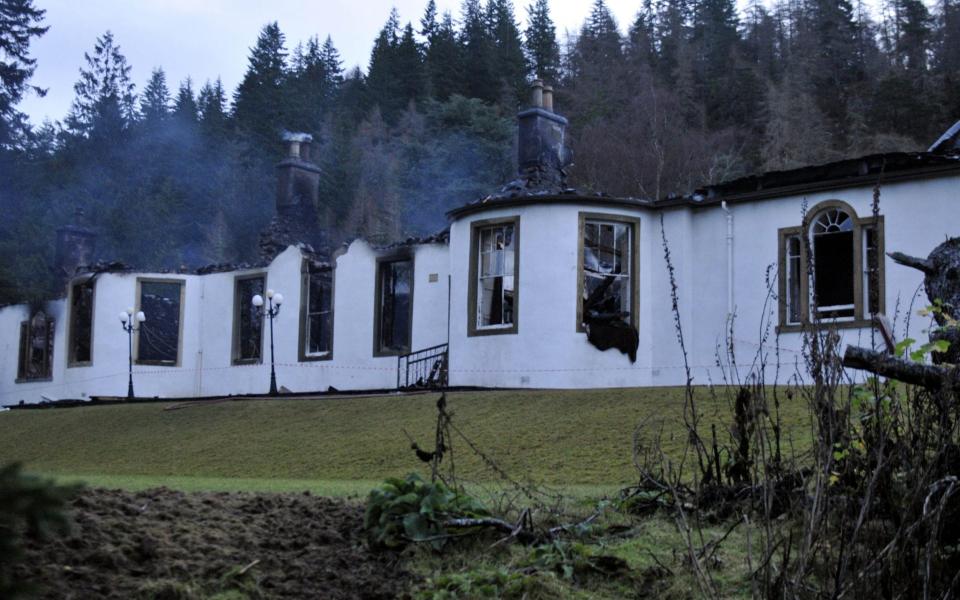House of the Devil: Aleister Crowley and the curse of Boleskine

When in 1899, Aleister Crowley, the poet, occultist and mountain-climber, who would rejoice in the sobriquet of "the Wickedest Man In The World", first moved into Boleskine House on the shores of Loch Ness, he found it necessary to write a letter of complaint to the local Vigilance Society.
"Prostitution," Crowley wrote, "is most unpleasantly conspicuous" in the area. An officer of the society was duly sent to investigate and, deeply puzzled, reported that they could find no evidence whatsover of prostitution. Crowley wrote back: "Conspicuous by its absence, you fools!"
Before moving to Boleskine, Crowley had been living in rooms in Chancery Lane, London, where he had fashioned two temples for his occult explorations - one white and lined with six huge mirrors; the other black, with an altar supported by the figure of a Black man standing on his hands, and with a human skeleton that Crowley would feed from time to time with blood, small birds and the like. "The idea," he explained "was to give it life, but I never got further than causing the bones to become covered with a viscous slime…"
Boleskine, he believed, provided a more favourable location for his occult practices, conducting a series of rituals from the Book of Abramelin - a mid–15th–century manuscript of a Jewish mystical provenance that would become central to Crowley’s new religion Thelema, which he believed would help him make contact with his holy guardian angel.
Crowley’s rituals were not a success, and he departed in 1913. But strange things have been happening at Boleskine House ever since. Long before Jimmy Page, the Led Zeppelin guitarist and Crowley afficianado, bought the house in the 1970s there were stories of hauntings, madness, suicide and suspected arson. But few things are more strange than the row that has broken out recently over plans to restore the Category B Listed Georgian structure, which was badly damaged by fire in 2015, back to residential use, while also allowing limited guided tours of its public rooms and grounds.

The proposal by the Boleksine House Foundation, which acquired the property last year, also includes the construction of "eco tourist" lodging on a separate site to accommodate the demand for holiday lets in the area.
But more than a hundred years after Aleister Crowley left the house, his ghost lingers on. Or so some appear to believe. A protest orchestrated by the Fresh Start Foundation which describes itself as a Scottish not for profit group "working with and for the survivors of Child Sexual Abuse and Satanist Ritual Abuse in Scotland" has said the plans will turn Boleksine House into "a pilgrimage site for satanists". The Boleskine House Foundation has described the allegations as "false and grotesquely unfounded".
Boleskine House was constructed in the late 18th century as a hunting lodge by Archibald Campbell Fraser of Lovat (1736–1815) - built on the site of a kirk, which, according to legend, had caught fire during a service and killed everyone inside. Archibald was the second son of the better known Simon Fraser, 11th Lord Lovat who had led the Fraser clan at the Battle of Culloden, and who was later captured and executed for treason at the Tower of London. The house would remain in the ownership of the Fraser family until 1894. Five years later, Crowley purchased Boleskine for £2,000 - twice its market value.
No sooner had Crowley moved in than he began to notice strange happenings in the house. Preparing talismans for his magical rituals, ‘squares of vellum inscribed in Indian ink’, in the sunniest room in the house he was obliged to use artificial light even on the brightest days. While the lodge and terrace, soon became peopled with "shadowy shapes, sufficiently substantial, as a rule, to be almost opaque".

Friends who came to stay felt impelled to depart rapidly and without explanation. One day, returning from shooting rabbits on the hill, Crowley found a Catholic priest in his study, bringing news the house’s lodgekeeper, ‘a total abstainer for 20 years’, had been raving drunk for three days and tried to kill his wife and children.
A housemaid is said to have gone mad, while a local butcher supposedly cut off his hand while dealing with Crowley’s order. Crowley sold Boleskine in 1913, and moved to America, where he spent the years of the First World War writing propaganda for the German cause. "A great deal of damage was done at the suburb of Croydon," he wrote of one Zeppelin raid over London, "especially at its suburb Addiscombe, where my aunt lives. Unfortunately her house was not hit." (Crowley later maintained he was actually working on behalf of British intelligence.)
In 1920, along with a handful of acolytes, he retreated to Sicily, where he established a temple of Thelema in a ramshackle farmhouse in the town of Cefalu. There he practiced sexual magic, earning the vehement attentions of the British yellow press, who recounted lurid stories of sexual orgies and animal sacrifice. (In his defense, his friend Gerald Yorke would point out that in a long life Crowley "only sacrificed a few sparrows, two pigeons, a cat, a goat and a toad, and of these the cat and goat were killed at ceremonies extemporized by request".)
The death in 1922 of an Oxford student staying in the farmhouse, was the final straw. Crowley was denounced by the press as "the wickedest man in the world", and kicked out of Italy by Mussolini.

Crowley had fallen into obscurity long before his death in a Hastings boarding-house in 1947. But in the Sixties there was a revival of interest in his life and work. His credo of ‘do what thou wilt shall be the whole of the law’ appeared to chime perfectly with the freewheeling hedonism of the Sixties and Seventies, excusing a multitude of sins – a word that did not figure highly in Crowley’s own vocabulary. He appears among the gallery of Beatle heroes assembled on the cover of the Sgt Pepper’s album (John Lennon’s choice), wedged between the Indian guru Sri Yukteswar Giri and Mae West. David Bowie dabbled in Crowley. Black Sabbath wrote a song about him.
The British R&B musician, Graham Bond, whose early quartet featured Ginger Baker, Jack Bruce and John McLaughlin, maintained that he was one of Crowley’s many illegitimate children, and set up a temple to Thelema in a space loaned by his record company. An increasingly disturbed figure, in 1974 he threw himself under a train at Finsbury Park Station.
But no-one dabbled more assiduously than Page. His interest in Crowley was apparently fired as a teenager when he stumbled upon a book about him. His biographer Chris Salewicz quotes Page as saying that he related to Crowley’s "system of self-liberation, in which repression is the greatest sin. It’s like being in a job when you want to be doing something else".
Page became an avid collector of Crowleiana - first editions, hats, canes, paintings – so extensive that other Crowleyites complained he was hogging the market. Among them was Kenneth Anger, the underground film-maker and occultist. Anger had been introduced to Crowley’s teachings in the 1940s by a woman named Marjorie Cameron, who along with Jack Parsons, a rocket engineer and a member of Crowley’s magical order, the OTO, had attempted to conceive a "moonchild" who would continue Crowley’s work. Parsons’ close associate at the time was Ron L Hubbard, the inventor of Scientology - but that’s another story.

In 1955, Anger, along with the sexologist Alfred Kinsey, visited Crowley’s Abbey of Thelema in Sicily, filming and photographing the remnants of the erotic murals daubed on the walls. Local peasants, fearing a revival of Crowleyism, greeted them with a traditional curse - a mutilated cat on the doorstep.
Anger came to Britain in the late Sixties, when he was working on his film, Lucifer Rising, steeped in Crowley’s teachings, and for a few months rented Boleskine House. It was around this time that Anger and Page met, at an auction at Sotheby’s, where both were bidding for a Crowley manuscript. "He, of course, had more money than I did," Anger would later remember. A friendship ensued, that would later end acrimoniously in an argument over the soundtrack Page was providing for Lucifer Rising.
In 1971, Page secured the ultimate Crowley trophy, buying Boleskine House. A few years earlier, the then owner, a Major Edward Grant, had killed himself with a shotgun in what had once been Crowley’s bedroom. But in interviews Page was quoted as saying that ‘at Boleskine it’s the atmosphere that counts and not the legends… When I go there with friends - writers and other creative people - I find that it crystallises things for them in a very short time. Of course it causes a lot of upheaval for some people as well."
But whatever strange things might have happened at the house in the past had nothing to do with Crowley, he maintained. "The bad vibes were already there," he said in an interview with Rolling Stone in 1975. ‘A man was beheaded there and sometimes you can hear his head rolling down. I haven’t actually heard it, but a friend of mine, who is extremely straight and doesn’t know anything about anything like that at all, heard it, he thought it was the cats bungling about. I wasn’t there at the time, but he told the help, 'Why don’t you let the cats out at night?’"
Page spent money on restoring Boleskine, including commissioning the artist and occultist Charles Pace, to paint murals inspired by those on the walls of Crowley’s Abbey of Thelema. Scenes from the Led Zeppelin film The Song Remains the Same were filmed in the grounds. But in the 19 years he owned the house, Page spent no more than a few months there.
Instead, he put it in the care of his friend Malcolm Dent. Over the years, Dent would report numerous strange occurrences and noises in the house, including passing what he described as "the most terrifying night of my life," when he was awakened by what sounded like a wild animal, snorting outside his bedroom door. Dent opened the door to find nothing, but added "whatever was there was very, very evil. And I was very, very frightened".

Another friend who stayed at the house awoke one night claiming she had been attacked by "some kind of devil."
"We just used to say that was Aleister doing his thing," Dent said. Nonetheless, he stayed on at Boleskine happily, raising his family there, until Page sold-up in 1991.
The house passed into private hands, but in 2015 it was almost completely destroyed by a fire in a suspected arson attack. In 2018 it was put on the Buildings at Risk Register for Scotland. At the same time, a paranormal research group, Highland Paranormal, conducted an investigation at the property, but were unable to detect any supernatural activity. The following year it was purchased by Kyra and Keith Readdy, who established the Boleskine House Foundation as a charitable trust. (Keith is a researcher in comparative religion and modern and contemporary Western esotericism, and the author of the book One Truth and One Spirit: Aleister Crowley’s Spiritual Legacy.)
A week after the Foundation purchased Boleskine House a second fire broke at the house, in yet another suspected arson attack, collapsing the roof of the property. In a bid to raise funds for the restoration, bags of fire-damaged remains, along with a certificate of authenticity, were put on sale on Ebay for £20.
As well as conducting tours of the house, they say they plan to establish a library consisting of works on Scottish history and heritage and Western esotericism.
A statement posted by the Trust on their website said: "There is no intention for the house to become a place of pilgrimage or ritual, nefarious or otherwise", and that "such matters’ are strictly prohibited by the Foundation’s constitution and, in any event, would be a breach of Scottish charities law.
"The house’s previous proprietors (most notably, parliamentary diplomat Archibald Campbell Fraser of Lovat, mountaineer and esoteric author Aleister Crowley and rock and roll musician Jimmy Page of Led Zeppelin fame) are all a part of the story of the place but they do not directly influence its future use.
"As historians and bastions of heritage conservation", the statement went on, "our take on Aleister Crowley is not one of sensationalism or alarmist conjecture as many will find in the popular press, but rather academic in nature, seeing Crowley as a historical and cultural figure of his time. Like that of King Henry VIII, Sigmund Freud, or the Beatles, Crowley’s works and activities should be seen in light of the historical context in which he lived, as a commentary on the human experience."
Crowley never returned to Boleskine after 1914. His last words were, supposedly, "I am perplexed."

